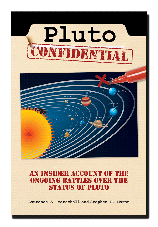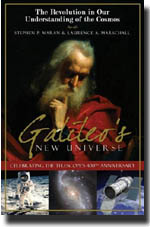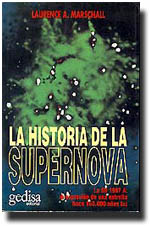Books by Laurence A. Marschall
Scroll Down or Click on an image above to See Details
PLUTO CONFIDENTIAL
An Insider Account of the
Ongoing Battles over the Status of Pluto
(2009)

By Laurence A.
Marschall and Stephen P. Maran
Published by Ben Bella Books
Listed on
Amazon.com (click to link)
From the Reviews
A Description Of The Book
When the International Astronomical Union adopted a new definition of a "planet"
in August 2006, Pluto became a dwarf planet, drawing a divisive line in science
and public opinions. The controversy of whether Pluto is a planet continues
years later, and passion about the decision remains, pitting scientist against
scientist and invoking sentiments and nostalgia from the rest of the world.
With the IAU definition, the future of space objects is forever changed. Learn
how this resolution came to be and what it means for astronomy, who implemented
it and who is against it, and whether it's the first or millionth time the
world's view of astronomy has rotated on its axis. Written by an
astronomer and educator who voted for the IAU resolution--Laurence A.
Marschall--and a former NASA scientist who supported the opposing petition that
resulted--Stephen P. Maran--Pluto Confidential leaves no perspective out and no
asteroid unturned in the Pluto debate. A telescopic look inside the book:
* History of planetary disputes, including why Jupiter almost wasn't
acknowledged * What Bode's Law is and how it has influenced observations * Who
discovered Pluto and how it was named * The Kuiper Belt and its role in what it
means to be a planet * Beyond Pluto and the eight distinguished planets
About the Authors
Stephen P. Maran worked at NASA for more than 35 years, on projects
including the Hubble Space Telescope. He is the author of more than 10
books, including The Astronomy and Astrophysics Encyclopedia and Astronomy
for Dummies, and is the press officer for the American Astronomical
Society. He has an asteroid named for him and has been awarded the NASA
Medal for Exceptional Achievement, the George Van Biesbroeck Prize of the
American Astronomical Society, and the Astronomical Society of the Pacific's
Klumpke-Roberts Award. He lives in Chevy Chase, Maryland. Laurence A.
Marschall is the W. K. T. Sahm Professor of Physics at Gettysburg
College and the author of The Supernova Story. He is a regular
columnist for Natural History, a contributing editor of
Smithsonian Air and Space, and an astronomy contributor for
The World Book Encyclopedia. He is the deputy press officer of the
American Astronomical Society and has been published in numerous
publications, including Astronomy, Discover, Harper's,
Newsday, and The New York Times Book Review. He lives in
Gettysburg, Pennsylvania.
GALILEO'S NEW UNIVERSE
(2009)

By Stephen P. Maran and Laurence A.
Marschall
Published by Ben Bella Books
Listed on
Amazon.com (click to link)
From the Reviews
"A charming peek into astronomy's family album, this lively
history is ideal for armchair scientists and stargazers."
----Publisher's Weekly
"....a fascinating read. Just enought technical to put you in awe, but
sensible enough that all - science types and art types - will thoroughly
enjoy the acquisition of heavenly knowledge."
---A Reader's Review on Amazon
A Description Of The Book
The historical and social implications of the telescope and that
instrument’s modern-day significance are brought into startling focus in
this fascinating account. When Galileo looked to the sky with his
perspicillum, or spyglass, roughly 400 years ago, he could not have fathomed
the amount of change his astonishing findings—a seemingly flat moon
magically transformed into a dynamic, crater-filled orb and a large, black
sky suddenly held millions of galaxies—would have on civilizations.
Reflecting on how Galileo’s world compares with contemporary society, this
insightful analysis deftly moves from the cutting-edge technology available
in 17th-century Europe to the unbelievable phenomena discovered during the
last 50 years, documenting important astronomical advances and the effects
they have had over the years.
THE SUPERNOVA STORY (1994)
Published by the Princeton Science Library, Princeton University
Press, 41 William Street, Princeton, NJ 08540
Listed on
Amazon.com (click to link)
A good read, a good reference,
and a good book for introductory astronomy classes.
From the reviews:
- "Marschall's supernova book is a superb piece of writing; it reads
almost as easily as a good novel"--Nature
- "This is a wonderful book about science, about astronomy, and of
course, about supernovae"-- American Journal of Physics
- "the book provides much more than the story of a single supernova,
adding an overview of the history of astronomy and good insights into how
astronomers work today. Solid, authoritative stuff, comfortably intelligible
to the interested but uninitiated reader...An excellent book from an
enthusiast who knows his subject and conveys his enthusiasm engagingly."--
New Scientist
 Press here
to connect to web bookstore, where you can order the book.
Press here
to connect to web bookstore, where you can order the book.


